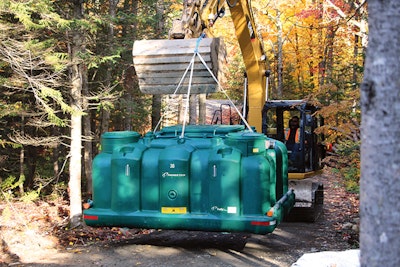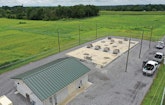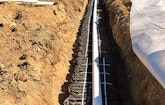Filter saves homeowner’s property value
Problem: A home in central Pennsylvania was listed for sale, and a septic inspection discovered a malfunctioning treatment system. The lot could not be retrofitted with an on-lot system, as nothing on the site would pass a perc test.
Solution: Harry Graham of Musser Engineering worked with the state Department of Environmental Protection to acquire a NPDES permit for a stream discharge disposal. The site required less than 10 TSS and less than 10 CBOD5, as well as a fecal count that was less than 200 microbial density. The engineer proposed an Ecoflo Coco Filter EC7-500/P-PACK unit from Premier Tech Aqua with an integrated UV light. No extra control panels were needed. The UV light has alarms for lamp failure and needed bulb replacement. The installer, Smartnick Farms, was familiar with the Ecoflo, with a prewired-unit and 100 feet of wire ready to go to the electric panel. He needed to dig one hole and pipe the system from the house and to the stream. The UV light has its own pump, and no extra pump tank was needed as the discharge was 5 feet higher than the tank.
Result: The unit with integrated UV light allowed the property to be transferred to the new owner with no problems. 800-632-6356; www.premiertechaqua.com.
Passive treatment unit used to replace failed system
Problem: A failed sand filter overboard discharge system on a shoreline needed to be replaced in Southport, Maine.
Solution: With the suggestion of the installer, the site evaluator decided on placing EnviroFin onsite treatment system from Presby Environmental in the same location as the previous sand filter system, as the sand was of the quality needed for the EnviroFin system. The treatment system is 100 percent passive and treats the effluent better than NSF Std. 40 standards. The installation includes two EnviroFin units at 270 gpd.
Result: The treatment system allowed for the customer to have the benefits of a treatment system without the large expense, maintenance contracts or electricity. 800-473-5298; www.presbyeco.com.
System minimizes maintenance for homeowner
Problem: Homes For Our Troops is an organization that builds specially adapted homes nationwide for severely injured veterans. One build project in Shelton, Washington, needed a treatment system, but the organization was looking for an option that would minimize future maintenance costs for the homeowner. The site had about 5 feet to the restrictive layer, loam soils and existing vegetation on the site.
Solution: Fred Kegel, P.E., designed an Eljen GSF, or Geotextile Sand Filter, system. The drainfield consists of three trenches with 15 A42 GSF modules in each trench. Bob Paysse of Pioneer Digging installed the system, including a pump chamber and dual compartment tank. Effluent for this system is pressurized by sleeving a pressure lateral through a 4-inch perforated pipe on top of the A42 modules before being dispersed over the GSF modules and into the ASTM C33 sand base below.
Result: The system was quickly installed, helping the build project to continue as planned so the veteran and his family could move into their new, accessible home. 800-444-1359; www.eljen.com.
System solves waste treatment challenges for rural town
Problem: The town of Section, Alabama, population 770, sought a solution to treat waste produced by both its residential and commercial entities.
Solution: ECOPOD units from Delta Treatment Systems were installed in poured-in-place concrete tanks equipped with aluminum hatches. A 14,208-gallon flow equalization tank was installed before the treatment reactor tanks to store the wastewater and evenly dose it to the treatment system throughout a 24-hour period. The tank includes duplex pumps to ensure flow surges don’t reduce treatment system efficiency. A 19,190-gallon primary tank precedes the flow equalization tank. The effluent also passes through a UV system for disinfection of fecal coliform to concentrations below permit levels. A drip disposal system includes an effluent pump chamber, headworks, tubing, controls and all necessary valves and fittings. A concrete building was erected on site by the project contractor to house electrical controls and equipment.
Result: Phase 1 of the two-phase project treats 30,000 gpd domestic waste at a strength of 300 mg/L for both BOD and TSS and handles an average daily flow fluctuation range of 50 to 100 percent. 800-219-9183; www.deltatreatment.com.









